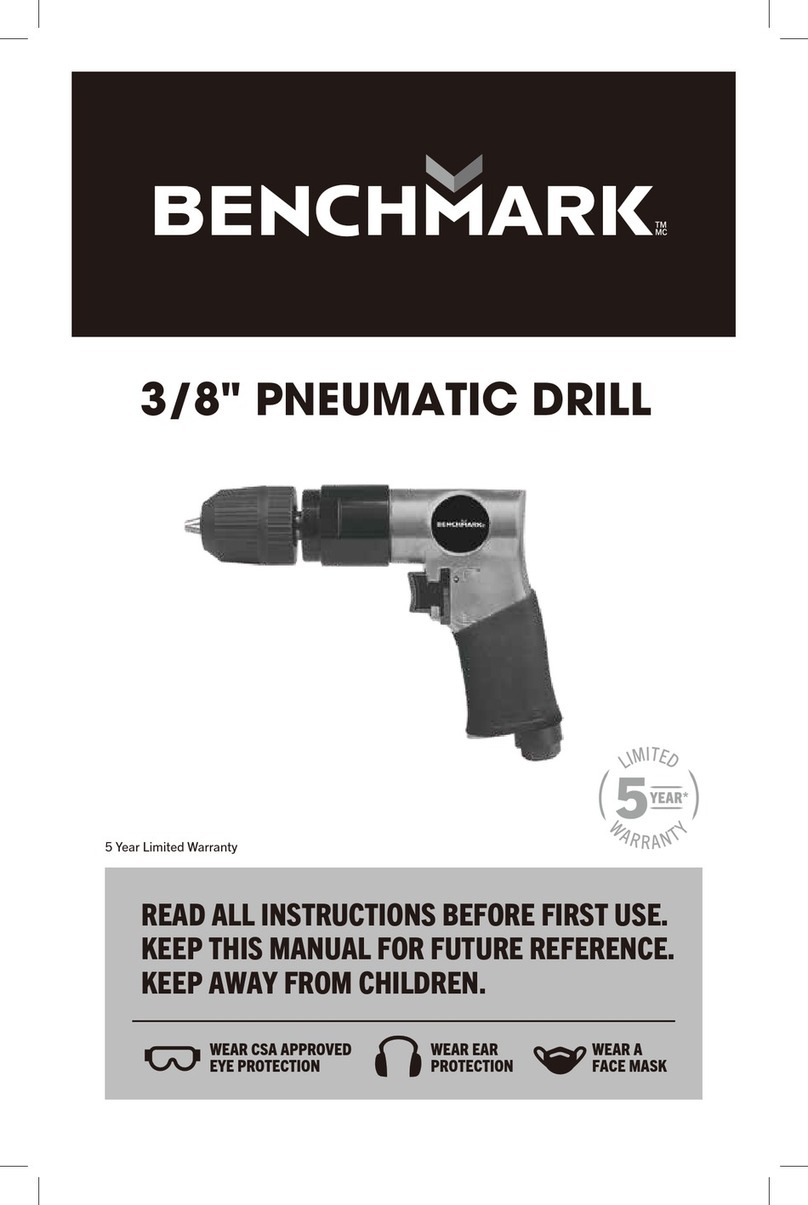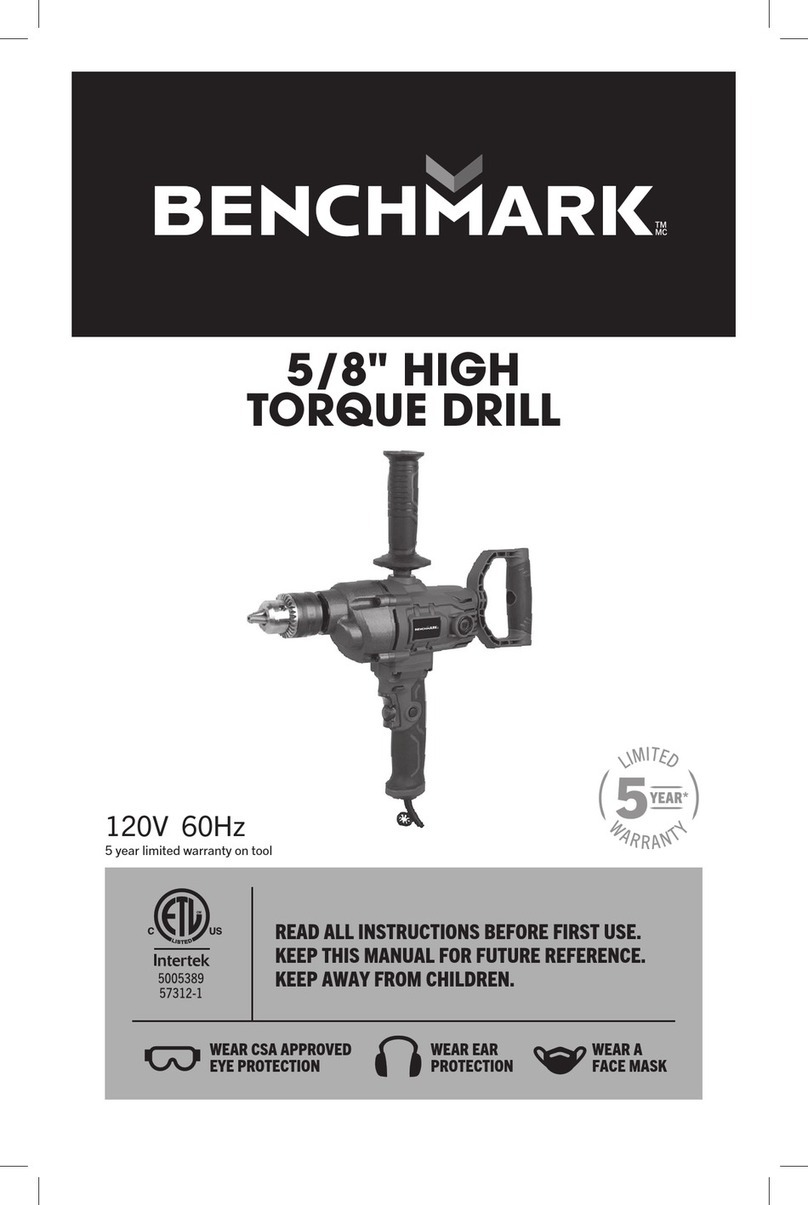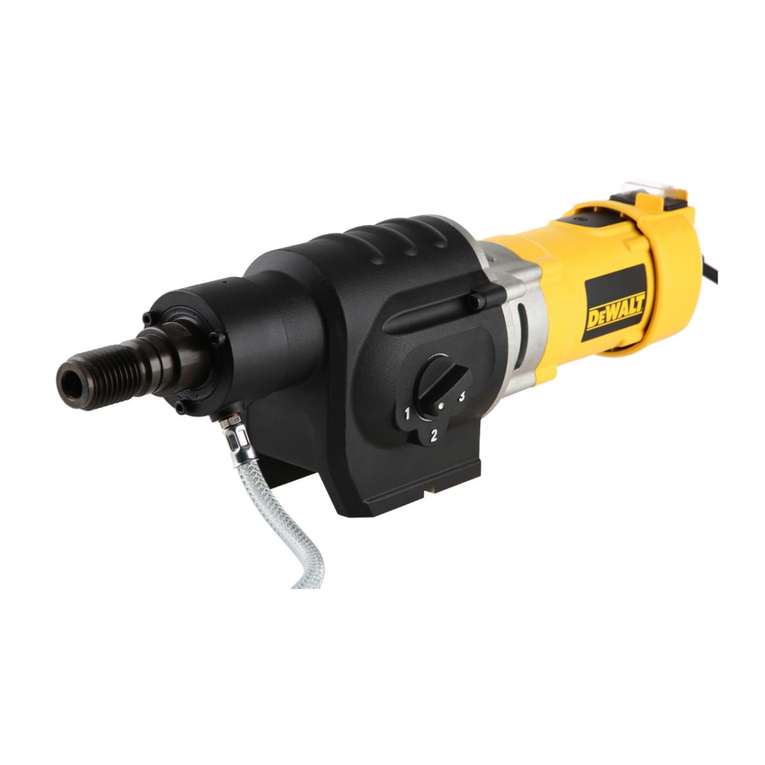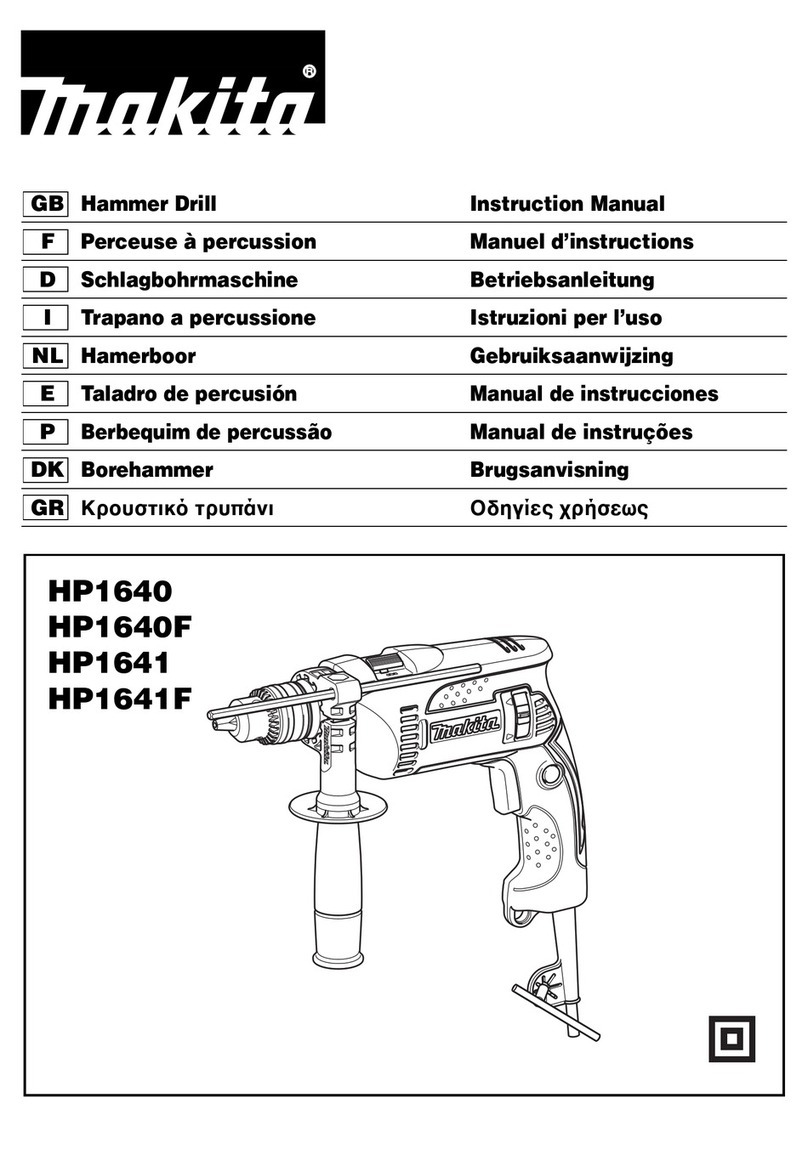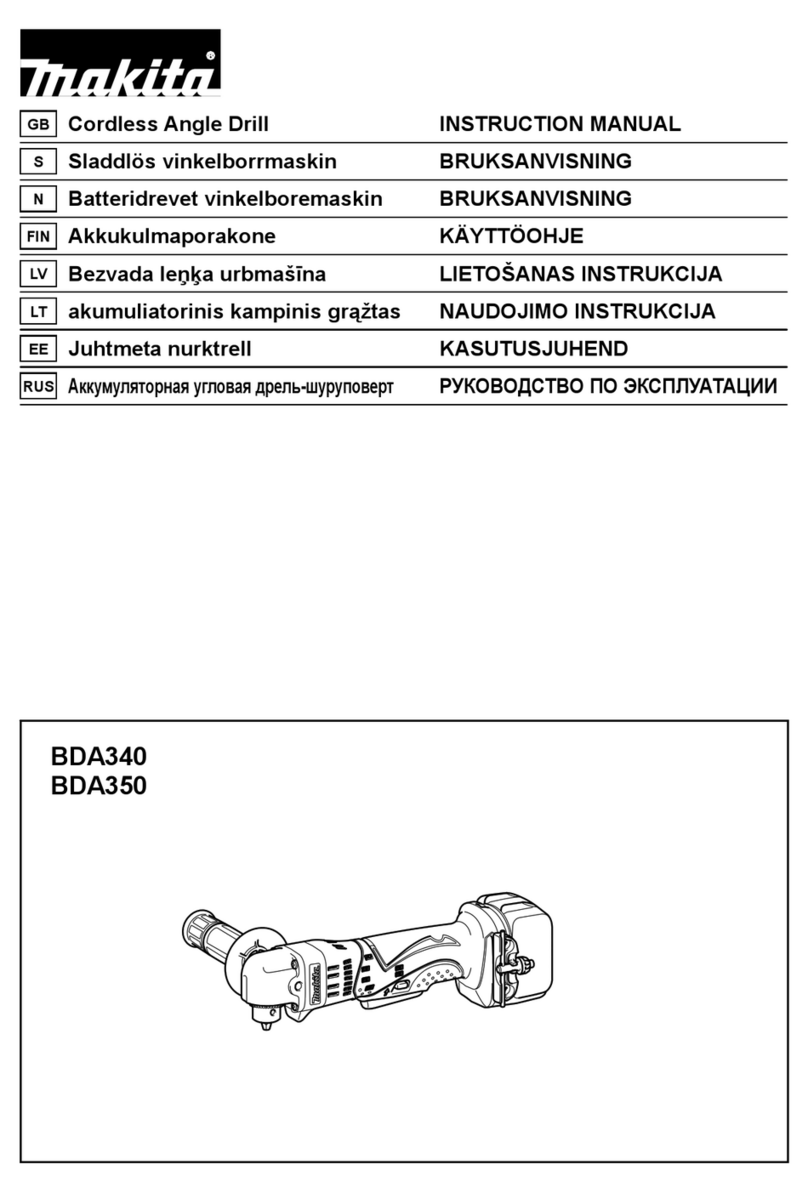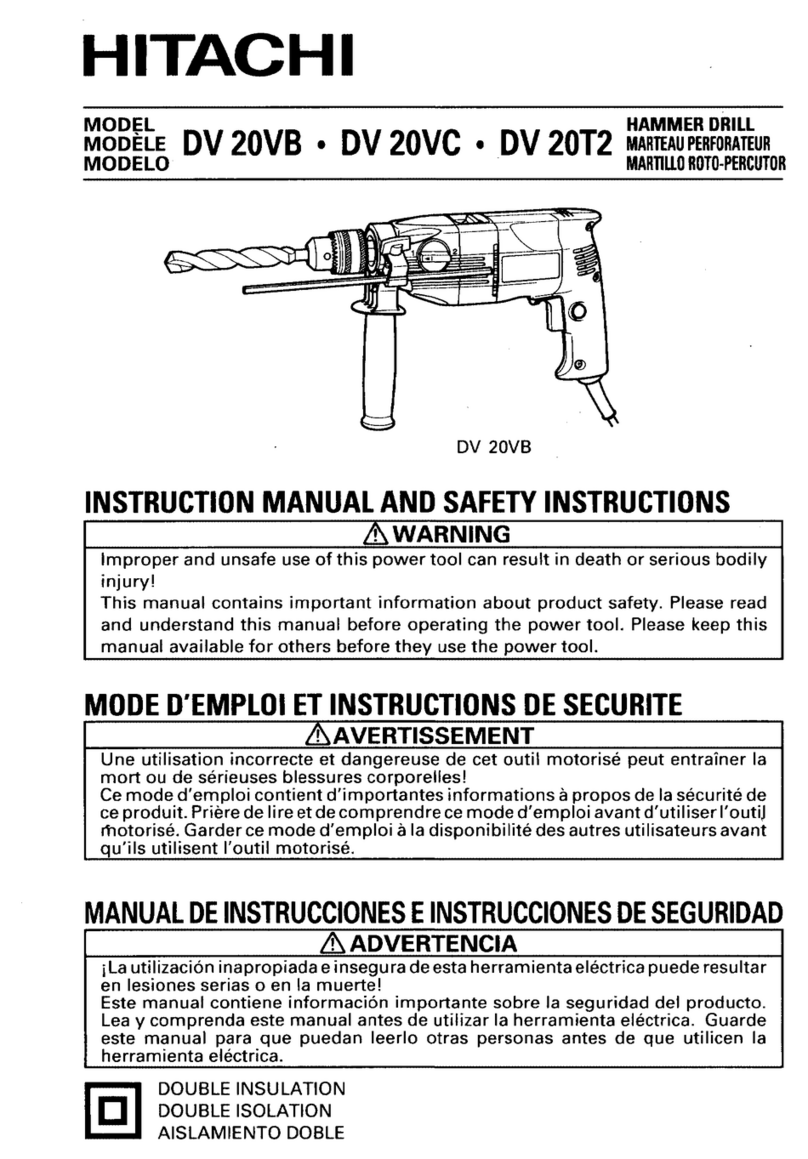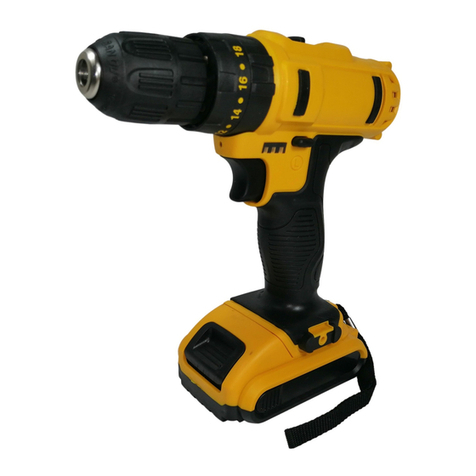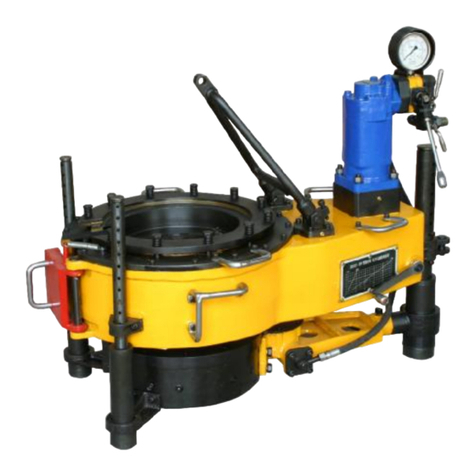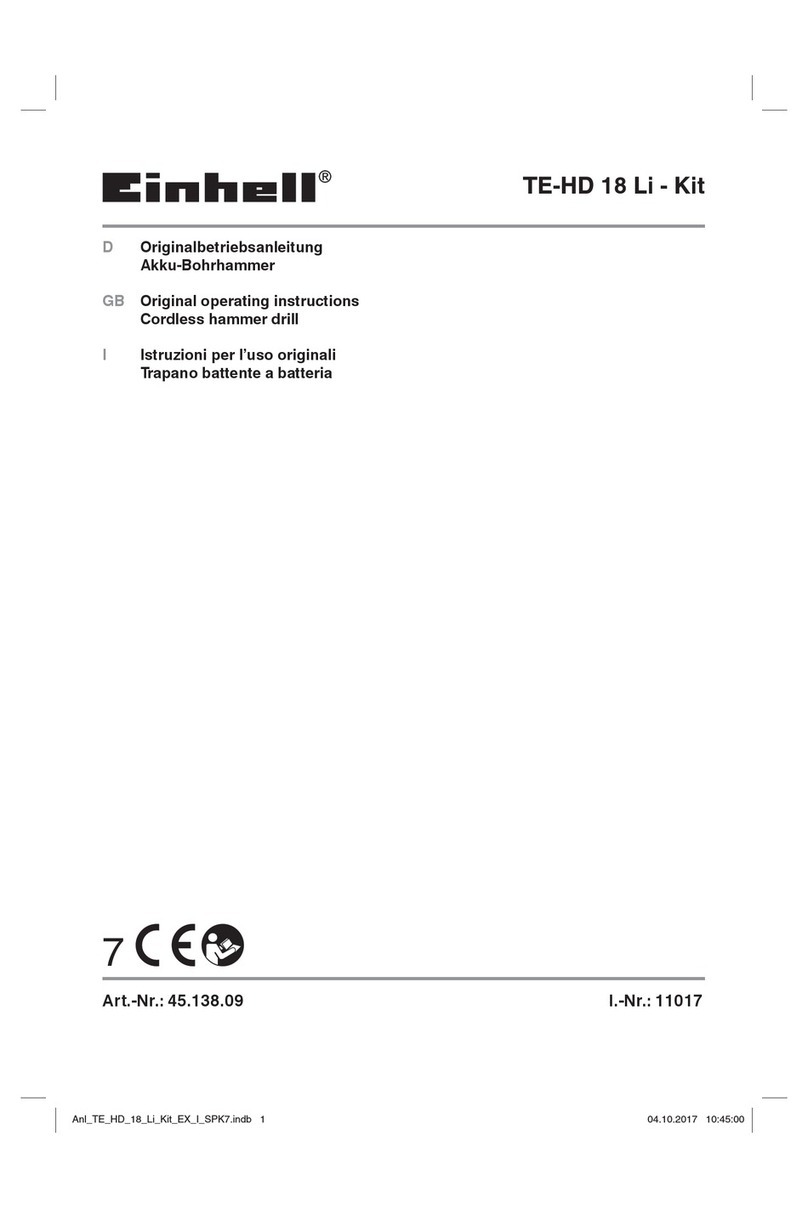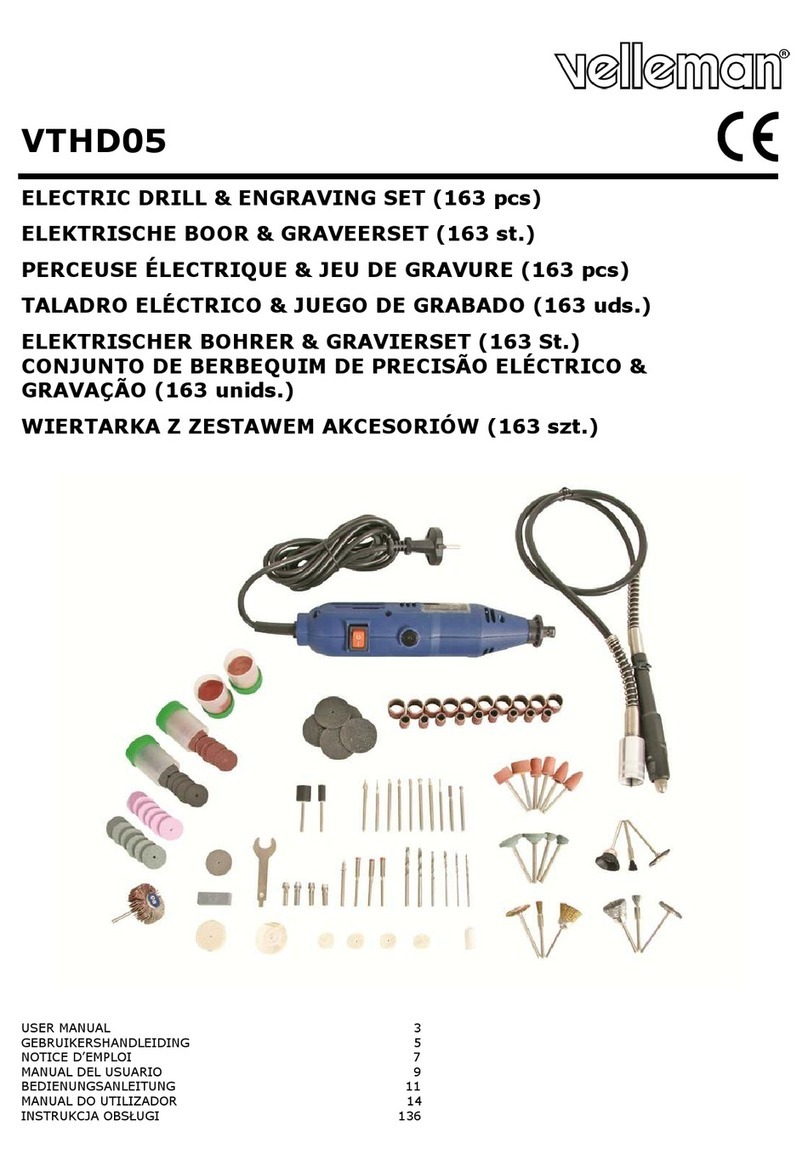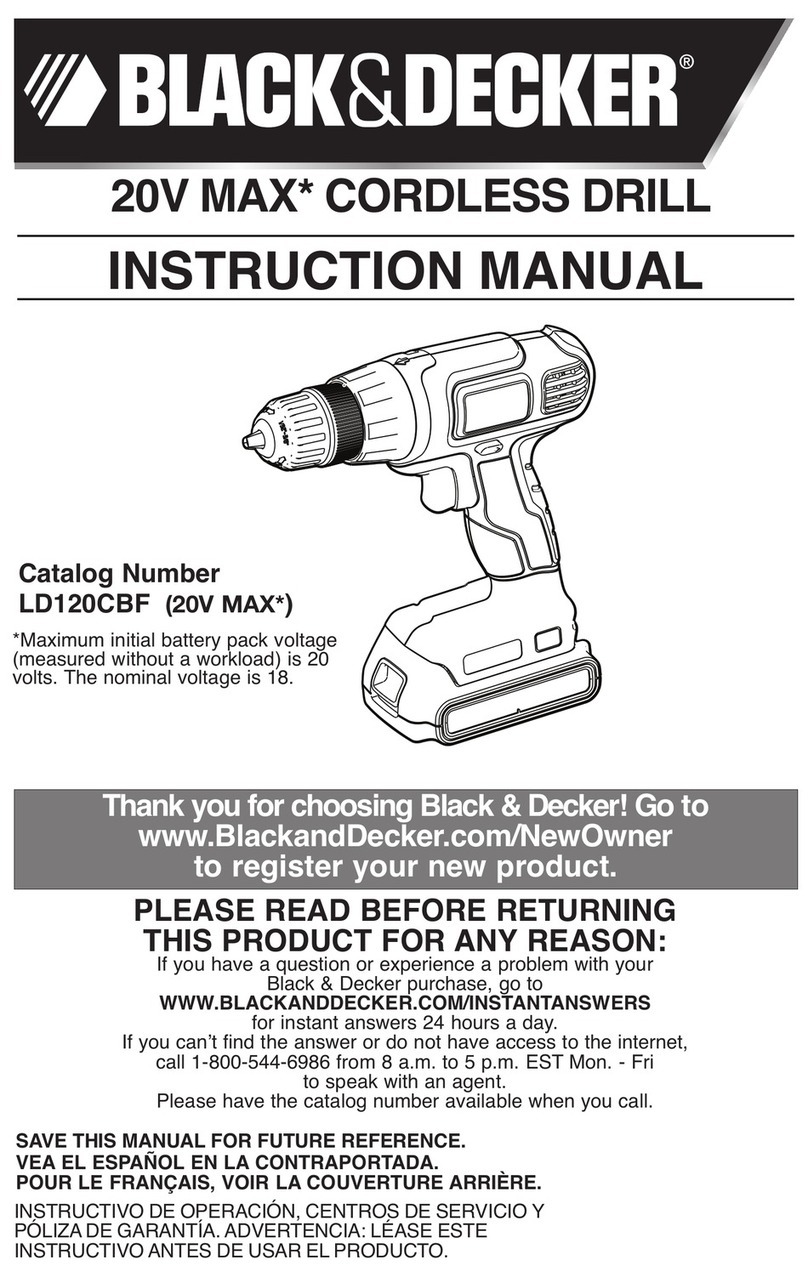Benchmark 1239-005 User manual

WEAR CSA APPROVED
EYE PROTECTION
WEAR EAR
PROTECTION
WEAR A
FACE MASK
3042597
JD6286C20
READ ALL INSTRUCTIONS BEFORE FIRST USE.
KEEP THIS MANUAL FOR FUTURE REFERENCE.
KEEP AWAY FROM CHILDREN.
Maximum initial battery voltage (measured without a load)
is 20 volts. Normal voltage is 18 volts.
5 Year Limited Warranty
3 Year Limited Warranty on Battery and Charger
20V MAX BRUSHLESS
1/2" HAMMER DRILL

1
PRODUCT SPECIFICATIONS
HAMMER DRILL
Variable chuck speed 0–600 RPM / 0–2,000 RPM (no load)
Variable hammer speeds 0-7,920/0-29,700 BPM
Torque clutch positions 20 + drill mode + hammer mode
Keyless chuck ½" keyless metal
Max torque 450 in/lbs.
Max drilling capacity in wood 1” (25mm)
Max drilling capacity in metal ½” (13mm)
Weight 4.2lbs. (1.9kg)
BATTERY AND CHARGER
Battery voltage 20 V Max 4Ah Li-ion (Maximum charged
battery voltage, measured without load, is 20V
with a nominal value of 18V)
Replacement battery 5350-011 (4Ah) Charge time – up to 120 minutes
Replacement charger 5350-010 (2.4A)
NEED ASSISTANCE?
Call us on our toll- free customer support line:
1-866-349-8665 (Monday through Friday 9am – 5pm Eastern Standard Time)
• Technical questions
• Replacement parts
• Parts missing from package

1239-005
20V MAX BRUSHLESS 1/2" HAMMER DRILL
2
TABLE OF CONTENTS
Product Specifications................................................................................... 1
Table of Contents........................................................................................... 2
General Safety Warnings ................................................................................ 3
General Safety Rules...................................................................................... 4
Specific Safety Rules For 20v 2vsr Hammer Drill............................................. 7
Symbols....................................................................................................... 10
Know your Cordless 20v 2vsr Hammer Drill .................................................. 11
Assembly and Operating .............................................................................. 12
Maintenance ............................................................................................... 21
Exploded View ............................................................................................. 22
Parts List ..................................................................................................... 23
Warranty...................................................................................................... 25

3
GENERAL SAFETY WARNINGS
WARNING:
Before using this tool or any of its accessories, read this manual and follow all Safety
Rules and Operating Instructions. The important precautions, safeguards and
instructions appearing in this manual are not meant to cover all possible situations.
It must be understood that common sense and caution are factors which cannot be
built into the product.
EYE, EAR & LUNG PROTECTION
SYMBOL MEANING
ALWAYS WEAR EYE PROTECTION THAT CONFORMS WITH CSA
Z94.3 or ANSI SAFETY STANDARD Z87.1
FLYING DEBRIS can cause permanent eye damage. Prescription
eyeglasses ARE NOT a replacement for proper eye protection.
Non-compliant eyewear can cause serious injury if broken during
the operation of a power tool.
Use hearing protection, particularly during extended periods of
operation of the tool, or if the operation is noisy.
WEAR A DUST MASK THAT IS DESIGNED TO BE USED WHEN
OPERATING A POWER TOOL IN A DUSTY ENVIRONMENT.
Dust that is created by power sanding, sawing, grinding, drilling, and
other construction activities may contain chemicals that are known
to cause cancer, birth defects, or other genetic abnormalities. These
chemicals include:
• Lead from lead-based paints
• Crystalline silica from bricks, cement, and other masonry products
• Arsenic and chromium from chemically treated lumber.
The level of risk from exposure to these chemicals varies, according to
how often this type of work is performed. In order to reduce exposure
to these chemicals, work in a well-ventilated area, and use approved
safety equipment, such as a dust mask that is specifically designed to
filter out microscopic particles.
To avoid electrical hazards, fire hazards or damage to the tool,
use proper circuit protection.
This tool is wired at the factory for 120 Volts AC operation. It must be
connected to a 120 Volts AC, 15 Amps circuit that is protected by a
time-delayed fuse or circuit breaker. To avoid shock or fire, replace
power cord immediately if it is worn, cut or damaged in any way.
Ventilation openings in batteries and chargers must always be open
to allow cooling air to circulate freely. Air vents that are blocked,
restricted, or covered may result in the battery or charger overheating.
Overheating may lead to damage to the tool or cause a fire, resulting in
possible serious injury.

1239-005
20V MAX BRUSHLESS 1/2" HAMMER DRILL
4
GENERAL SAFETY RULES
WARNING: Read all safety warnings and all instructions. Failure to follow the
warnings and instructions may result in electric shock, fire and/or serious injury.
Save all warnings and instructions for future reference.
WORK AREA SAFETY
Keep work area clean and well lit. Cluttered or dark areas invite accidents.
Do not operate power tools in explosive atmospheres, such as in the presence
of flammable liquids, gases or dust. Power tools create sparks which may ignite
the dust or fumes.
Keep children and bystanders away while operating a power tool. Distractions can
cause you to lose control.
ELECTRICAL SAFETY
Power tool plugs must match the outlet. Never modify the plug in any way.
Do not use any adapter plugs with earthed (grounded) power tools. Unmodified
plugs and matching outlets will reduce risk of electric shock.
Avoid body contact with earthed or grounded surfaces such as pipes, radiators,
ranges and refrigerators.There is an increased risk of electric shock if your body
is earthed or grounded.
Do not expose power tools to rain or wet conditions. Water entering a power tool
will increase the risk of electric shock.
Do not abuse the cord. Never use the cord for carrying, pulling or unplugging
the power tool. Keep cord away from heat, oil, sharp edges or moving parts.
Damaged or entangled cords increase the risk of electric shock.
When operating a power tool outdoors, use an extension cord suitable
for outdoor use. Use of a cord suitable for outdoor use reduces the risk of
electric shock.
If operating a power tool in a damp location is unavoidable, use a residual
current device (RCD) protected supply. Use of a ground fault circuit interrupter
(GFCI) protected supply. Use of a ground fault circuit interrupter (GFCI) reduces
the risk of electric shock.
PERSONAL SAFETY
Stay alert, watch what you are doing and use common sense when operating
a power tool. Do not use a power tool while you are tired or under the influence
of drugs, alcohol, or medication. A moment of inattention while operating power
tools may result in serious personal injury.
Use personal protective equipment. Always wear eye protection. Protective
equipment such as dust mask, non-skid safety shoes, hard hat, or hearing
protection used for appropriate conditions will reduce personal injuries.
connecting to power source and/or battery pack, picking up or carrying the
tool. Carrying power tools with your finger on the switch or energizing power tools
that have the switch on invites accidents.

5
Remove any adjusting key or wrench before turning the power tool on.
A wrench or a key left attached to a rotating part of the power tool may result
in personal injury.
Do not overreach. Keep proper footing and balance at all times. This enables
better control of the power tool in unexpected situations.
Dress properly. Do not wear loose clothing or jewellery. Keep your hair, clothing,
and gloves away from moving parts. Loose clothes, jewellery or long hair can be
caught in moving parts.
If devices are provided for the connection of dust extraction and collection
facilities, ensure these are connected and properly used. Use of dust collection
can reduce dust-related hazards.
POWER TOOL USE AND CARE
Do not force the power tool. Use the correct power tool for your application.
The correct power tool will do the job better and safer at the rate for which
it was designed.
Any power
tool that cannot be controlled with the switch is dangerous and must be repaired.
Disconnect the plug from the power source and/or the battery pack from the
power tool before making any adjustments, changing accessories, or storing
power tools. Such preventive safety measures reduce the risk of starting the
power tool accidentally.
Store idle power tools out of the reach of children and do not allow persons
unfamiliar with the power tool or these instructions to operate the power tool.
Power tools are dangerous in the hands of untrained users.
Maintain power tools. Check for misalignment or binding of moving parts,
operation. If damaged, have the power tool repaired before use.
Many accidents are caused by poorly maintained power tools.
Keep cutting tools sharp and clean. Properly maintained cutting tools with sharp
cutting edges are less likely to bind and are easier to control.
Use the power tool, accessories, and tool bits etc. in accordance with these
instructions, taking into account the working conditions and the work to be
performed.
could result in a hazardous situation.
Hold power tools by insulated gripping surfaces when performing an operation
where cutting tool may contact hidden wiring or its own cord. Contact with a
“live” wire will make exposed metal parts of the tool “live” and shock the operator.
Hold power tool by insulated gripping surfaces, when performing an operation
where the fastener may contact hidden wiring or its own cord. Fasteners
contacting a "live" wire may make exposed metal parts of the power tool “live”
and could give the operator an electric shock.

1239-005
20V MAX BRUSHLESS 1/2" HAMMER DRILL
6
BATTERY TOOL USE AND CARE
Recharge only with the charger specified by the manufacturer. A charger
that is suitable for one type of battery pack may create a risk of fire when used
with another battery pack.
Use power tools only with specifically designated battery packs.
Use of any other battery packs may create a risk of injury and fire.
When battery pack is not in use, keep it away from other metal objects, like
paper clips, coins, keys, nails, screws, or other small metal objects that can
make a connection from one terminal to another. Shorting the battery terminals
together may cause burns or a fire.
Under abusive conditions, liquid may be ejected from the battery; avoid
contact. If contact accidentally occurs, flush with water. If liquid contacts
eyes, additionally seek medical help. Liquid ejected from the battery may
cause irritation or burns.
SERVICE
Have your power tool serviced by a qualified repair person using only identical
replacement parts. This will ensure that the safety of the power tool is maintained.

7
SPECIFIC SAFETY RULES
WARNING: Know your cordless hammer drill. Do not plug in the charger or
install the battery in the tool until you have read and understand this Instruction
Manual. Learn the tool’s applications and limitations, as well as the specific
potential hazards related to this tool. Following this rule will reduce the risk of
electric shock, fire, or serious injury.
Always wear eye protection. Any power tool can throw foreign objects
into your eyes and cause permanent eye damage. ALWAYS wear
safety goggles (not glasses) that comply with ANSI safety standard
Z87.1. Everyday glasses have only impact resistant lenses.
They ARE NOT safety glasses.
WARNING: Glasses or goggles not in compliance with ANSI Z87.1
could cause serious injury when they break.
WARNING: Always use a safety shield, hearing protection and dust mask
when drilling concrete.
WARNING: To avoid fire or toxic reaction, never use gasoline, naphtha,
acetone, lacquer thinner or similar highly volatile solvents to clean the tool.
WARNING: Use only accessories that are recommended for this cordless
drill. Follow the instructions that accompany the accessories. The use of improper
accessories may result in injury to the operator or damage to the tool.
WARNING: If any part is missing or damaged, do not plug the tool into the
power source or install any accessory until the missing or damaged part is replaced.
Do not drill material too small to be securely held.
Always keep hands out of the path of the drill bit. Avoid awkward hand positions
where a sudden slip could cause your hand to move into the path of the drill bit.
Secure the workpiece. Use clamps or a vice to hold the workpiece. It is safer than
using your hand and it frees both hands to operate the tool.
Make sure there are no nails or foreign objects in the part of the workpiece
to be drilled.
To avoid injury from accidental starting, always remove the battery from the tool
before installing or removing a drill bit.
Do not install or use any drill bit that exceeds 7” (17.5 cm) in length or extends
more than 6" (15 cm) beyond the chuck jaws. They can bend or break suddenly.
Before starting the operation, jog the drill switch to make sure the drill bit does not
wobble or vibrate.
Do not use fly cutters or multiple-part hole cutters, because they can come apart
or become unbalanced during use.
Make sure the spindle has come to a complete stop before touching the chuck
or attempting to change the drill bit.
Always make sure the chuck is tight and the drill bit firmly tightened in the chuck
before starting drill.

1239-005
20V MAX BRUSHLESS 1/2" HAMMER DRILL
8
BATTERY & CHARGER SAFETY
WARNING: Only use the charger supplied with this kit to charge the 20V Li-ion
batteries for this tool. Charging any other batteries may damage the charger and
possibly cause serious injury.
Do not store or carry the battery in a manner in which metal objects could contact
the exposed metal end. Do not place the battery in aprons, pockets, drawers, etc.
with loose nails, screws, keys etc. The battery could short circuit causing a fire,
personal injury, or damage to the battery.
Never attempt to open the battery for any reason. If the housing of the battery
breaks or cracks, immediately discontinue use and do not recharge.
Do not charge the battery if it is wet or shows any evidence of corrosion.
A small leakage from the battery may occur under extreme usage, charging or
temperature conditions. This does not indicate a failure. However, if the outer
seal is broken and this leakage gets on your skin, follow these steps:
1. Wash immediately with soap and water.
2. Neutralize with a mild acid such as lemon juice or vinegar.
3. If liquid gets into your eyes, flush immediately with clean water for a
minimum of 10 minutes and seek medical attention.
NOTE: The battery liquid is slightly acidic.
Do not incinerate the battery. It can explode in a fire.
Do not use an extension cord. Plug the charger cord directly into an electrical outlet.
Use the charger only in a standard 120V, 60 Hz electrical outlet.
Do not use the charger in wet or damp conditions. It is intended for indoor use only.
Do not use the charger near sinks or tubs. Do not immerse the charger in water.
Do not allow the cord to hang over the edge of a table or counter or touch
hot surfaces.
The charger should be placed away from sinks and hot surfaces.
Do not use the charger to charge any batteries other than the cordless drill
batteries. Other batteries may explode.
Do not allow the cord to hang over the edge of a table or counter or touch hot
surfaces. The charger should be placed away from sinks and hot surfaces.
Do not operate charger if the cord or plug is damaged. Replace the damaged
cord and plug immediately.
Do not operate the charger if it has received a sharp blow, been dropped or
otherwise damaged in any way. Have a qualified technician examine the charger
and repair it if necessary. Do not disassemble the charger.
Do NOT charge the batteries when the work area or the battery temperature is
at or below 5° C (41° F) or above 40.5° C (105° F).
Unplug the charger when not in use and before cleaning or maintenance.

9
BATTERY PACK RECYCLING
To preserve our natural resources, please recycle or dispose
of batteries properly. The batteries charged by this charger
may contain chemicals and metals that are harmful to the
environment. Never dispose of rechargeable batteries in your
normal household garbage or in landfill sites as they will add to the
pollution of the environment.

1239-005
20V MAX BRUSHLESS 1/2" HAMMER DRILL
10
SYMBOLS
WARNING: Some of the following symbols may appear on the drill. Study these
symbols and learn their meaning. Proper interpretation of these symbols will allow
V Volts n
~
Three-phase alternating
current with neutral
A Amperes Read all documentation
Hz Hertz Direct current
W Watts noNo load speed
kW Kilowatts Alternating or direct current
Microfarads Class II Construction
L Litres Splash-proof construction
kg Kilograms Watertight construction
H Hours Protective grounding at
terminal, Class I tools
N/cm² Newtons per square
centimetre .../min Revolutions or reciprocations
per minute
Pa Pascals Diameter
OPM Oscillation per minute 0
Min Minutes Directional Arrow
S Seconds Warning symbol
~or AC Alternating current Wear eye protection
~
Three-phase alternating
current Wear hearing protection
3042597
JD6286C20
This symbol designates that this tool is listed with Canadian and U.S.
requirements by ETL Testing Laboratories, Inc.
Conforms to UL Std. UL 60745-1 and 60745-2-1 60745-2-2.
Certified to CAN/CSA Std. C22.2 No. 60745-1 and 60745-2-1 60745-2-2.

11
KNOW YOUR BENCHMARK
20V MAX BRUSHLESS 2VSR HAMMER DRILL
Battery Charger
5350-010
Two speed gear
box switch
Forward /
reverse switch
Bits on
board
Keyless chuck
Torque clutch
LED Work light
Trigger switch
Battery
5350-011
Air vents
Red LED
Green LED

1239-005
20V MAX BRUSHLESS 1/2" HAMMER DRILL
12
ASSEMBLY AND OPERATING
CHECKING THE BATTERY CHARGER STATUS
The level of charge remaining in the battery can be checked by using the battery
LED power indicator that is contained on the end of the battery.
NOTE: The battery charge remaining may be checked while the battery is installed
in the tool with the ON/OFF switch turned OFF. It may also be checked while the
battery is removed from the tool. DO NOT check the battery charge remaining while
the battery is in the charger.You will get a false reading and you may also damage
the battery status system.
1. Press and hold the battery status button located on the end of the battery.
2. One or more of the Four LED lights in the LED window will come ON to indicate
the amount of charge that is remaining in the battery as follows:
Charge level
indicator
Amount of charge
remaining 10-25% 25-50% 50-75% 75-100%
3. Release the battery status button to turn the LEDs OFF.
CHARGING THE BATTERY PACK
1. Place the battery charger (1) in a dry location near a 110–120V 60 Hz
2. Plug the battery charger into the outlet and make sure the green LED
indicator light (5) comes ON. If it does not, refer to the chart (Fig. 2)
to identify the problem.
3. Turn the battery (2) upside down and slide it onto the charger.
NOTE: Make sure the grooves (3) in the sides of the battery slide over the
matching tabs on the charger (4) until the battery latch “clicks” into place.

13
NOTES:
1. When the charger is plugged into the wall receptacle and NO battery
is on the charger, the green indicator light (5) will turn ON indicating the
charger is “live”.
2. When a discharged battery is installed on the charger, the green indicator light
will turn OFF and the red indicator light (6) will turn ON. The red indicator light
indicates the battery is being charged.
3. If the red indicator light does not come ON, check to make sure battery pack
is slid fully onto the charger and the electrical outlet is working properly.
4. See Fig. 2 below for other indicator light functions.
5. A discharged battery pack should be fully charged in approximately 2 hrs.
6. It is normal for the battery charger to hum and be warm to the touch
during operation.
7. If the battery pack does not charge properly, check to make sure the electrical
outlet is “live”.
8. Do NOT charge batteries when the work area or the battery temperature
is at or below 5°C / 41°F or above 40.5°C / 105°F.
GREEN
LIGHT
RED
LIGHT
BATTERY
INSERTED
INTO CHARGER
CHARGING STATUS
ON OFF NO Charger connected
to power supply
OFF Blink YES Battery being
charged
ON OFF YES Battery fully charged
OFF ON YES Battery is charged
but not operational
on tool. This may
indicate defective /
bad contact
on battery.
ON ON YES Charging conditions
are either too hot
or too cold
Fig. 1 Fig. 2
INSTALLING A BATTERY ON THE HAMMER DRILL
1. Remove the discharged battery (1) from the drill by pressing downward on the
battery release button (2) and sliding the battery backward until it is removed
from the drill handle (3) (Fig. 3).
2. Slide the fully charged battery onto the matching keys (4) in the drill handle
where the discharged battery has been removed.
NOTE: Make sure the slots in the battery are fully engaged with the mounting keys
in the drill handle. The battery release button will “click” into place when the battery
is fully installed.

1239-005
20V MAX BRUSHLESS 1/2" HAMMER DRILL
14
WARNING: Do not immerse the battery pack in water. Sudden cooling could
cause a hot battery to explode or leak.
ADJUSTING THE TORQUE
“hammer drilling”.
The proper setting depends upon the type of material, the size of screw being used,
and the function required.
Adjust the torque setting as follows:
1. Identify the torque settings located on the torque adjustment ring (1) (Fig. 4).
2. Rotate adjustment ring to align the correct torque setting number with the
torque indicator arrow (2). See the chart below for the correct torque settings.
• 1–4 For driving small screws.
• 5–8 For driving medium sized screws into soft materials.
• 9–14 For driving screws into soft & medium-density materials.
• 15–20 For driving screws into hardwood, and for driving larger screws.
• For drilling. This position is marked with a drill bit icon on the torque
adjustment ring.
• Use the highest setting indicated by the hammer icon for hammer mode
on the torque adjustment ring.
FORWARD/REVERSE SWITCH
The forward/reverse switch (1) is conveniently mounted above the trigger switch
(2) (Fig. 5). To make the drill rotate clockwise (for drilling) push the forward/reverse
switch to the left. To make the drill rotate counter clockwise for removing screws,
push the forward/reverse switch to the right.
NOTES:
a) Never change the position of the forward/reverse switch while the
chuck is turning.
b) The trigger switch will NOT function with the forward/reverse switch
in the middle position.
Fig.3
1
2
4 3

15
Fig. 4
Fig. 5
VARIABLE-SPEED TRIGGER SWITCH
This drill is equipped with a variable-speed ON/OFF trigger switch.
1. To start drill, gently squeeze the trigger switch (2) (Fig. 6).
NOTE: The drill will turn at its slowest speed when the trigger switch is
depressed slightly. The drill will turn at its fastest speed when the trigger
switch is fully depressed.
2. To stop the drill, release the trigger switch.
Fig. 6 Fig. 7
NOTE: Drilling at a slow speed for an extended period of time may cause the drill
motor or the battery pack to overheat. If either the drill or the battery gets hot, stop
drilling and allow them to cool for at least 15 minutes.
LED WORK LIGHT
The LED work light (3) will automatically turn ON when the trigger switch is
squeezed (Fig. 7). It will automatically turn OFF when the trigger switch is released.
NOTE: The LED light has a 20 second time delay.
TWO-SPEED GEAR BOX SWITCH
The two-speed gear box switch is located on the top of the drill housing. Set the
speed-control switch to the desired speed before starting the drill. Slide the speed-
control switch FORWARD.
(Fig. 8a) for low-speed operation. Slide the speed control-switch BACK (Fig. 8b)
for high-speed operation.
1
1
2
2 4 6 8 10
2
3

1239-005
20V MAX BRUSHLESS 1/2" HAMMER DRILL
16
NOTES:
a) Use low-speed setting for drilling large holes and for driving screws.
b) Use high-speed setting for drilling smaller holes.
c) Do NOT change the speed-control switch position while drill is turned ON.
Damage to the gears may result.
INSTALLING DRILL BITS
WARNING: Never hold the chuck body with one hand and use the drill power
to rotate the drill body to loosen or tighten bits. Serious injury may result.
This drill is equipped with a keyless chuck.
1. To open the keyless drill chuck, grasp and hold the chuck (1) with one hand
(Fig. 9). and rotate in a counterclockwise direction until the chuck jaws (2)
open wide enough to accept the bit (3).
2. Insert the bit into the chuck the full length of the jaws. Raise the front of your
drill slightly to prevent the bit from falling out of the chuck jaws.
3. Tighten the chuck jaws onto the bit by turning the chuck body in a clockwise
direction.
NOTE: Make sure the bit is properly aligned in the jaws and NOT at an angle.
An improperly aligned bit could be thrown from the chuck when drill is started.
Make sure flat sides of the screwdriver bit are being grasped by the chuck jaws.
4. Finish tightening the chuck jaws by holding the chuck collar with one hand
and firmly tightening the chuck body by rotating it in a clockwise direction.
NOTE: Hand tighten the chuck jaws. Do NOT use pliers. You will damage the chuck.
WARNING: Do not insert the drill bit into the chuck and tighten as shown in
Fig. 10. The drill bit MUST be properly inserted with all three of the chuck jaws
holding the bit centered in the chuck. Failure to properly insert the drill bit could
cause the drill bit to be thrown from the chuck, resulting in possible serious injury
or damage to the chuck.
2
3
1
Fig. 9

17
REMOVING BITS
1. To open the keyless drill chuck, grasp and hold the chuck body and rotate
it in a counterclockwise direction until the chuck jaws open wide enough
to release the bit.
2. Remove the drill bit.
WARNING: For safety reasons, the operator must read the sections of
this Owner’s Manual entitled "GENERAL SAFETY WARNINGS", "POWER TOOL
SAFETY", "SPECIFIC SAFETY RULES", "BATTERY & CHARGER SAFETY" and
"SYMBOLS" before using this cordless drill.
Verify the following every time the cordless drill is used:
1. Safety glasses, safety goggles, or face shield is being worn.
2. Hearing protection is being worn.
3. The chuck has not worked loose on the spindle.
4. The bit is in good condition and is properly tightened onto the chuck.
Failure to observe these safety rules will significantly increase the risk of injury.
DRILLING
When drilling into smooth, hard surfaces such as metal, use a center punch to mark
hole is started.
The workpiece to be drilled should be secured in a vice or with clamps to keep it
from turning as the drill bit rotates (Fig. 11).
1. Check the drill bit to make sure it is firmly locked into the drill chuck and verify
that the forward/reverse switch is in the forward position.
2. Set the torque clutch to the drilling position.
3. Hold the drill firmly with both hands whenever possible. Use one hand to grasp
the handle and switch.
NOTE: Make sure the hand placed on the body of the drill does not cover the air
vents. Covering these air vents will reduce motor cooling, and possibly lead to
overheating the motor.
4. While holding the drill firmly, place the point of the drill bit at the point to be
drilled. Squeeze the switch trigger to start the drill.
NOTES: Always use a higher drill speed when drilling small holes. Use a slower drill
speed when drilling large holes.
Fig. 10

1239-005
20V MAX BRUSHLESS 1/2" HAMMER DRILL
18
5. Move the drill bit into the workpiece applying only enough pressure to keep the
bit cutting. Do not force the drill bit or apply sideways pressure to elongate the
hole.
WARNING: Be prepared for binding and bit breakthrough. When these
situations occur, the drill bit has a tendency to grab the workpiece. This action
will kick the drill opposite to the direction of the drill bit rotation and could
cause loss of control when breaking through material as you complete drilling
the hole. If you are not prepared, this loss of control can result in serious injury.
When drilling metals, use light oil on the drill bit to keep it from overheating. The oil
will prolong the life of the drill bit and improve the cutting action. If the bit jams in
the workpiece, or if the drill stalls, release the trigger switch immediately. Remove
the bit from the workpiece and determine the reason for jamming.
DRIVING SCREWS
When driving screws, care must be taken to use the bit that correctly fits the screw
being driven. Make sure you use the largest bit size that will properly fit into the
head of the screw.
1. Select the correct screwdriver bit for the screw being driven.
2. Fasten the screwdriver bit into the chuck, making sure the flat sides of the bit
are gripped by the chuck jaws.
3. Set the torque clutch to the appropriate setting.
NOTE: If the workpiece material is particularly soft or porous, set the torque clutch
to a lower setting to avoid overdriving the screw.
4. If the screw is driven too far into the workpiece before the clutch releases, set
the clutch to a lower setting, and do not pull the trigger switch fully back. If the
screw is not driven far enough into the workpiece, set the clutch to a higher
setting.
NOTE: Do not continue to drive the screw once the clutch has released. This causes
unnecessary wear of the clutch.
Fig. 11

19
REMOVING THE CHUCK
1. Remove the battery pack from the drill.
2. Insert a 5/16” (8 mm) or larger hex key (1) into the chuck (2) and tighten the
chuck jaws securely (Fig. 12). Make sure each of the chuck jaws (3) is seated on
the flat surfaces of the hex key.
3. Tap the hex key sharply with a mallet (4) in a CLOCKWISE direction. This action
will loosen the screw in the chuck for easy removal.
4. Open chuck jaws and remove the hex key.
5. Open the chuck jaws as far as possible.
6. Remove the chuck screw using a #2 screwdriver (Fig. 13).
NOTE: Turn the screw CLOCKWISE to remove it. This screw has a left-handed
thread.
7. Insert the hex key into the chuck and tighten jaws of chuck securely (Fig. 14).
Tap the hex key sharply with a mallet in a COUNTER-CLOCKWISE direction.
This will loosen the chuck on the spindle. The chuck can now be unscrewed and
removed from the spindle by hand.
RETIGHTENING A LOOSE CHUCK
1. Remove the battery pack from the drill.
2. Insert a 5/16” (8 mm) or larger hex key (1) into the chuck (2) and tighten the
chuck jaws securely (Fig. 15). Make sure each of the chuck jaws (3) is seated on
the flat surfaces of the hex key.
4
2
3
1
Fig. 13
Fig. 12
Table of contents
Other Benchmark Drill manuals

